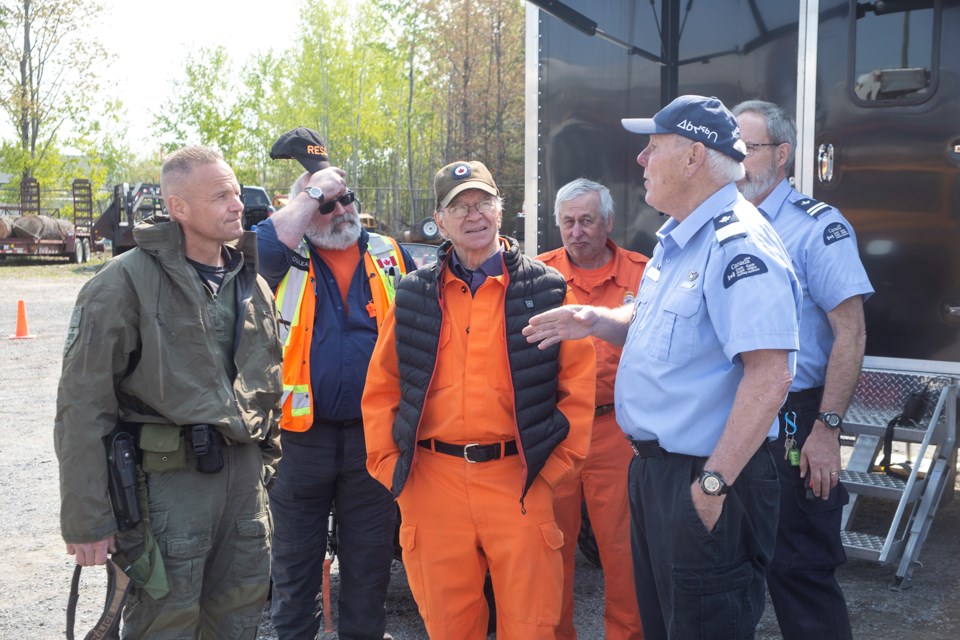The timing couldn’t have been more coincidental for a "Police Week" showcase of local search and rescue partnerships, staged just days after the successful search for a missing 11-year-old girl.
Held Wednesday at the Sault Search and Rescue headquarters on Industrial Park Crescent, the event brought together many of the agencies and people who were involved in the recent search for Ruby Kerr, the young girl found after more than 24 hours in the wilderness nine kilometres from the St. Kateri outdoor learning centre.
That kind of positive outcome is the reason many people volunteer with the organization, said Sault Search and Rescue coordinator Dennis O’Reilly.
“That is what I have told the team many times over the years, the one time you are involved in bringing that child home to their parents — that’s going to pay the bill emotionally for the rest of your time in this business,” said O’Reilly. “When I heard the news that she was found I had that same feeling again, it’s the best feeling you can have.”
In operation since 1958, Sault Search and Rescue has assisted in countless searches for missing persons in Sault Ste. Marie and surrounding area.
O’Reilly noted searches do not always have a happy ending.
“The payoff is those occasions when you are successful, the downside is you have to live with those that aren’t. That’s just the nature of the beast,” he said. ”The best search doesn’t always end in the best result, that’s just the way it is.”
The Sault Ste. Marie Police Service was among the search and rescue partners present for Wednesday’s showcase, which was planned prior to Kerr's disappearance. On display was the department’s drone, ATVs and new Mobile Command Unit trailer — all used last weekend in the search for Kerr.
The department’s search coordinator during Kerr’s disappearance was Acting Sergeant Greg Vallee, who was on hand during Wednesday’s showcase.
Vallee said it took a lot of hours and expertise from a number of agencies to bring Kerr home. Those partner organizations included the Ontario Provincial Police and Ministry of Natural Resources, among others.
“It definitely shines on the importance of training and being ready too, and keeping up the relationships with all of these other agencies,” he said. “She is a tough little girl, it’s amazing, really.”
The experiences gained from every search — successful or not successful — help to inform future operations, said Vallee.
This case was unique, said Vallee, because Kerr was not expected to be found nine kilometres from where she was last seen.
“I don’t know if I would change anything as far as coordination goes, but in hindsight it’s a little easier because I know where she was after the fact. I wish I had pushed resources that way but at the time I had no idea,” he said.
Trained searchers will begin with a relatively small perimeter from the last known sighting and eventually spread out further and further.
“If you make the decision to pull resources and put them somewhere else you leave a hole in that higher priority area and it’s a gamble,” said Vallee. “It’s the conflict of increasing the perimeter. With the resources, are you going to skip past that spot?”
O’Reilly said he was surprised by some of the comments he heard while the search was still ongoing.
“There were reactions we hadn’t seen before and we had to sort of get our minds around that whole notion about why wasn’t the Amber Alert signalled,” he said. “I had never experienced a reaction like that from the community before and there has been a lot of attempts to explain that and how it works.”
O’Reilly also noted the interest by the general public to assist in the search. The police told concerned citizens on the weekend to keep their distance and let the search and rescue teams do their work.
O’Reilly explained that if members of the public were brought in to help search, they would need to be supervised by an experienced searcher.
“Every set of feet on the ground is important and we don’t have the luxury of being able to say to a guy: 'Here, deal with these citizens,'” said O’Reilly. “Some people are going to do it anyway and then suddenly one of them doesn’t come back, now you have two people missing and that just compounds the problems.”
The public is generally not brought in to assist with a search in the early stages, he said.
“I expect if it had gone on a little longer we would have brought some people in to assist,” said O’Reilly.
Vallee said from his perspective as search coordinator, bringing in untrained searchers to a remote area like the one around St. Kateri can add to the liability and can result in false sightings.
“Now you're sending your resources even thinner because you’re chasing down more potential leads, and you don’t want that. It can be helpful in certain situations, but in this scenario it could have been difficult,” he said. “I don’t want these people getting lost and then you have more problems.”
O’Reilly said he hopes last weekend's high-profile search will increase interest in the national Adventure Smart program, which Sault Search and Rescue presents to area schools. It includes teaching the concept of "Hug-a-Tree" to kids.
“If you get turned away and get away from the group and you don’t know which way to go — just stay there and we will find you,” he said.
